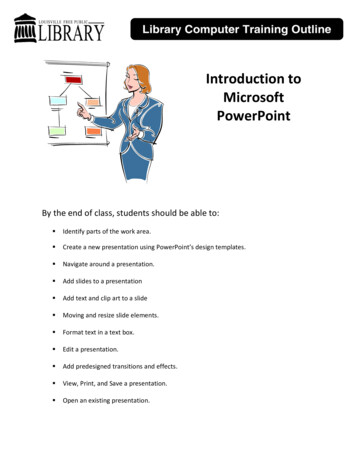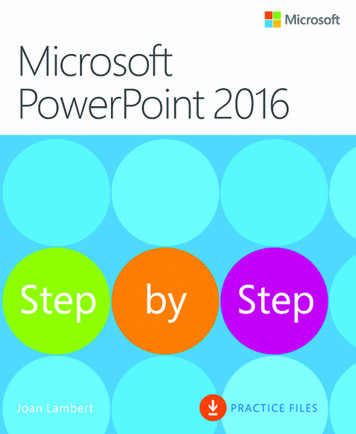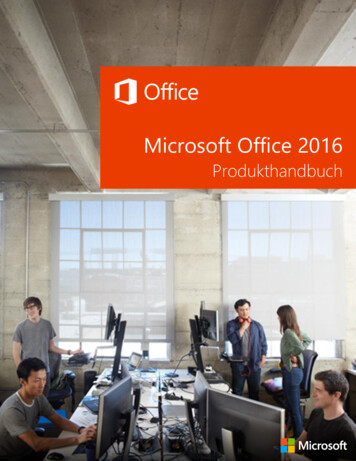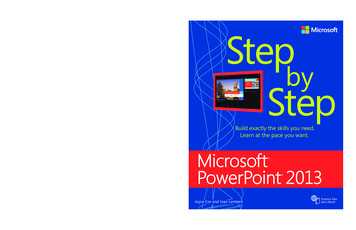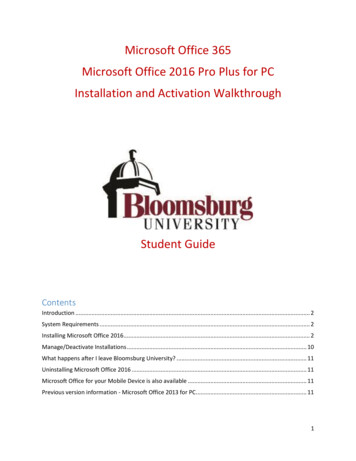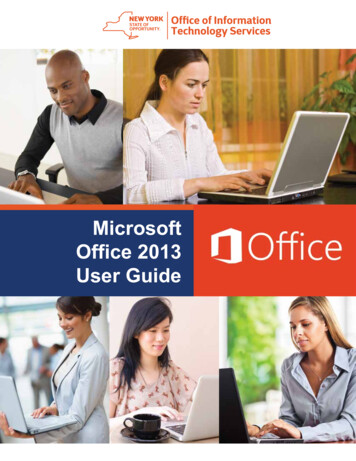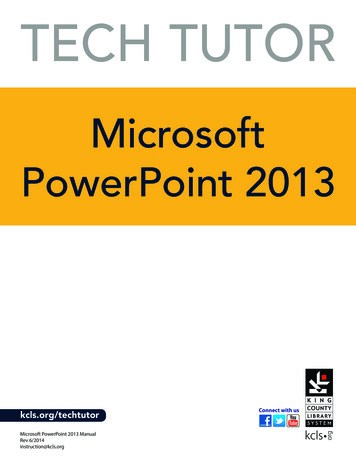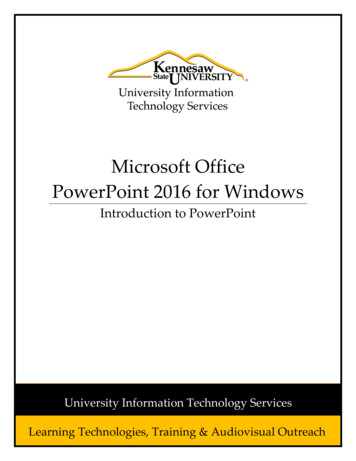
Transcription
Microsoft OfficePowerPoint 2016 for WindowsIntroduction to PowerPointUniversity Information Technology ServicesLearning Technologies, Training & Audiovisual Outreach
Copyright 2016 KSU Division of University Information Technology ServicesThis document may be downloaded, printed, or copied for educational use without further permissionof the University Information Technology Services Division (UITS), provided the content is not modifiedand this statement is not removed. Any use not stated above requires the written consent of the UITSDivision. The distribution of a copy of this document via the Internet or other electronic mediumwithout the written permission of the KSU - UITS Division is expressly prohibited.Published by Kennesaw State University – UITS 2016The publisher makes no warranties as to the accuracy of the material contained in this document andtherefore is not responsible for any damages or liabilities incurred from UITS use.Microsoft product screenshot(s) reprinted with permission from Microsoft Corporation.Microsoft, Microsoft Office, and Microsoft PowerPoint are trademarks of the Microsoft Corporation.
University Information Technology ServicesMicrosoft Office: PowerPoint 2016 for WindowsIntro to PowerPointTable of ContentsIntroduction . 5Learning Objectives. 5Best Practices for Creating Presentations: . 5The Microsoft PowerPoint 2016 Interface . 6The Ribbon . 7The Quick Access Toolbar . 7Tell Me . 9Search for Features . 9Get Help with PowerPoint . 9The Smart Lookup Tool . 11Galleries . 13Mini Toolbar . 13Status Bar . 13Themes . 14The File Tab . 17Navigation . 18Slides Pane . 18Slide Preview . 18Notes Pane . 18Changing Views . 19Types of Views . 19How to Create a New Presentation . 20Saving a Presentation . 20File Formats. 20How to Save a Presentation . 21
Appearance . 22Slides . 22Adding a New Slide . 22Types of Slide Layouts . 23Text. 24Entering Text . 24Adding a Text Box . 24Formatting Text. 25Graphics . 25Inserting Pictures . 26Images from a File . 26Inserting an Image from a file . 27Draw Shapes . 27Inserting a Shape. 27Altering a Shape . 27Hyperlinks . 28Adding a Hyperlink . 28Header and Footer . 29Adding a Header or Footer . 29Printing . 30Printing Your Presentation . 30Additional Help . 33
IntroductionMicrosoft Office PowerPoint 2016 is a presentation software application that aids users in the creationof professional, high-impact, dynamic presentations. Slides are the building blocks of a PowerPointpresentation. By using slides, the focus is not only on the speaker, but on the visuals (slides) as well.Learning ObjectivesAfter viewing this booklet, you will be able to: Become familiar with PowerPoint’s interface Create a new presentation and save it Add slides to a presentation Delete and Rearrange slides Apply a design theme Work with themes and background styles Use the various PowerPoint views Enter and edit text Insert graphics and other objects Play the slideshow Print handoutsBest Practices for Creating PresentationsSlide layout, font, color scheme, and content are the main components to developing a greatpresentation. Follow the guidelines below to create a good presentation: Identify the critical information that needs to be presented and include it in your presentation. Use no more than six bullet points per slide. Keep bullet points short and to the point. Incomplete sentences are okay. Minimize the number of font types used in your presentation. Keep font sizes consistent. Do not make all of the text uppercase. For contrast, use a light-colored font on a dark background and vice versa. Use bold formatting to make appropriate words stand out. Minimize the use of italics. They are more difficult to read. Do not vary the look of one slide greatly from the next. Consistency is key. Identify text that can be represented pictorially and use appropriate graphics in its place. Remove unnecessary graphics that are not relevant to the information presented. Use consistent colors and font size on each slide. Do not use unusually bright colors. Do not clutter the slides with too many graphics. Use graphics and transitions sparingly.Revised: 6/28/2016Page 5 of 33
The Microsoft PowerPoint 2016 InterfaceThere are a number of prominent changes to the look and functionality of Microsoft PowerPoint 2016.Let us have a look at its latest interface.Figure 1 - The Interface1. Quick Access Toolbar - Allows you to keep shortcuts to your favorite and frequently used tools.2. Ribbon Display Options - You can collapse, auto hide, or show the whole ribbon.3. File Tab (Backstage View) - The backstage view is where you manage your files and theinformation/properties about them (e.g. open, save, print, protect document, etc.).4. Ribbon - Tabbed interface, where you can access the tools for formatting your presentation.The Home tab will be used more frequently than the others.5. Tell Me - Look up PowerPoint tools, get help, or search the web.6. Collapse the Ribbon- This button will collapse the ribbon. Click on the pinned icon to re-openthe ribbon.7. Mini Toolbar - Select or right-click text or objects to get a mini formatting toolbar.8. Slides Tab - Use this to navigate through your slides within your presentation.9. Slide - This is where you type, edit, insert content into your selected slide.10. Status Bar - View which slide you are currently on, how many slides there are, speaker notes orcomments in your presentation, change your views, or change your zoom level.Page 6 of 33
The RibbonThe ribbon is a panel that contains functional groupings of buttons and drop-down lists organized bytabs (see Figure 2). The ribbon is designed to help you quickly find the commands that you need tocomplete a task.Figure 2 - The RibbonThe ribbon is made up of a set of tabs that pertain to the different functionalities of PowerPoint, suchas designing slides, inserting media onto slides, or applying animations. Each tab is further divided intological groups (of buttons), such as the Font group shown in Figure 1 above.There are also “contextual tabs” that appear, depending on what you are working on.For example, if you have inserted pictures, the Picture Tools tab appears whenever a picture is selected(See Figure 3).Figure 3 - Contextual TabThe Quick Access ToolbarThe Quick Access Toolbar is a small toolbar at the top left of the application window that you cancustomize to contain the buttons for the functions that you use most often.Figure 4 - Quick Access ToolbarPage 7 of 33
To customize the Quick Access Toolbar:1. Click the drop-down arrow on the far right (See Figure 5).2. Click on any listed command to add it to the Quick Access Toolbar (See Figure 5).3. Click More Commands to choose from a comprehensive list of commands (See Figure 5).Figure 5 - Customize Quick Access Toolbar4.5.6.7.Select a command from the list by clicking on it (See Figure 6).Click the Add button (See Figure 6).Repeat steps 4 & 5 to add additional commands (See Figure 6).Click on the OK button to confirm your selection (See Figure 6).Figure 6 - Quick Access Toolbar OptionsPage 8 of 33
Tell MeThe Tell Me feature allows users to enter words and phrases related to what you want to do next toquickly access features or actions. It can also be used to look up helpful information related to thetopic. It is located on the Menu bar, above the Ribbon.Search for Features1. Click in the Tell Me box.Figure 7 - Tell Me2. Type the feature you are looking for (See Figure 8).3. In the Tell Me drop-down, you will receive a list of features based on your search. Click theFeature you were looking for (See Figure 8).Figure 8 - Select a Feature4. You will either be taken to the feature or a dialog box of that feature will open.Get Help with PowerPoint1. Click in the Tell Me box.Figure 9 - Tell MePage 9 of 33
2. Type the feature you want help with (See Figure 10).3. In the Tell Me drop-down, click Get Help on “feature” (See Figure 10).Figure 10 - Get Help on Feature4. In the PowerPoint 2016 Help dialog box, you will get a list of help topics based on your search.Click the Topic you wanted help with.Figure 11 – PowerPoint 2016 HelpPage 10 of 33
The Smart Lookup ToolSmart Lookup uses Bing to provide you with search results for your selected term or phrase. It islocated under the Review tab within the Insights section. The following explains how to use the SmartLookup functionality.1. Highlight the word or phrase you want to find information about (See Figure 12).2. Right‐click on the word or phrase.3. Click Smart Lookup (See Figure 12).Figure 12 - Smart LookupPage 11 of 33
4. The Insights pane displays the information relevant to your selection. In the Insights pane, youreceive the following information:a. Explore - Wiki articles, image search, and related searches from the internet(See Figure 13).b. Define - A list of definitions (See Figure 13).Note: The Insights pane uses the Microsoft search engine Bing. For Smart Lookup to work you haveto be connected to the internet.5. To close the Smart Lookup Insights pane, click the Exit (X) button in the top right corner of thepane (See Figure 13).Figure 13 - Insights PanelPage 12 of 33
GalleriesA Gallery is a collection of pre-defined formats which can be applied to various elements in Officeapplications, such as the Themes Gallery in PowerPoint (See Figure 14). A Gallery most often appearsas a result of clicking on an item on one of the Ribbon tabs.Figure 14 - Theme GalleryThe selections in a Gallery incorporate a feature called Live Preview. When the mouse cursor hoversover a selection in a Gallery, your document takes on the formatting attributes of that selection inorder to give you a preview of how that selection will look when applied to your document.Mini ToolbarThe Mini Toolbar is a semi-transparent toolbar that appears when you select text (See Figure 15).When the mouse cursor hovers over the Mini Toolbar, it becomes completely solid and can be used toformat the selected text.Figure 15 - Mini ToolbarStatus BarThe Status Bar can be customized to display specific information. Below, in Figure 16, is the defaultStatus Bar for PowerPoint:Figure 16 - Status BarPage 13 of 33
Right-clicking on the Status Bar brings up the menu to the right, which enables you to change thecontents of the Status Bar by checking or un-checking an item (See Error! Reference source notfound.).Figure 17 - Status Bar MenuThemesA Theme is a set of formatting options that is applied to an entire presentation. A theme includes a setof colors, a set of fonts, and a set of effects. Using themes shortens formatting time and provides aunified, professional appearance.The Themes group is located on the Design tab; it allows you to select a theme from the ThemesGallery, apply variants, and customize the colors, fonts, and effects of a theme(see Figure 18 on the next page).Figure 18 - Design Tab: ThemesApplying a Theme to a Presentation1. On the Ribbon, select the Design tab (See Figure 18).2. In the Themes group, hover over a theme with your mouse to see a preview.3. Click the arrows to scroll to additional themes.Figure 19 - ThemesPage 14 of 33
4. Select a theme by clicking on the thumbnail of your choice within the Themes group.Applying a Theme Variant1. On the Ribbon, select the Design tab (See Figure 18).2. In the Variants group, hover over a variant with your mouse to see a preview.3. Click the down-arrow to view any additional variants (See Figure 20).4. Select a variant by clicking the thumbnail of your choice within the Variants group.Figure 20 - Variants GalleryChanging the Color Scheme of a ThemeIt may be necessary to change the color of a theme to better suit your presentation. In order tochange the color scheme after applying a theme to your presentation:1. From the Variants group, click the down arrow with the line above it, in the bottom rightcorner.Figure 21 - Variants Drop-down2. Select colors from the menu.Figure 22 - Variants Menu3. Select a color scheme from the list that appears.Page 15 of 33
Changing the Fonts of a ThemeIn order to change the fonts of an applied theme:1. From the Variants group, click the down arrow with the line above it, in the bottom rightcorner (See Figure 21).2. Select Fonts from the menu.Figure 23 - Fonts3. Select your desired font from the list that appears.Changing the Effects of a ThemeIn order to alter the visual effects of an applied theme:1. From the Variants group, click the down arrow with the line above it, in the bottom right corner(See Figure 21).2. Select Effects from the menu.Figure 24 - Effects3. Select your desired effect from the list that appears.Page 16 of 33
The File TabThe File tab, shown below in Figure 25, provides a centralized location called the Microsoft OfficeBackstage view (see Figure 26). The Backstage view is used for all tasks related to PowerPoint filemanagement: opening, creating, closing, sharing, saving, printing, converting to PDF, emailing, andpublishing. The Backstage view also allows for viewing document properties, setting permissions, andmanaging different versions of the same document. (See the PowerPoint 2016 Quick Guide located athttp://uits.kennesaw.edu/cdoc, for additional information on the Backstage View).Figure 25 - File TabFigure 26 - Backstage ViewPage 17 of 33
NavigationPowerPoint 2016 opens in the Normal View showing the Slides Pane on the left side of the window.Slides Pane1. The Slides pane shown on in Figure 27, displays all the slides available in a presentation andhelps to navigate through the presentation. The slides are listed in sequence and you canshuffle the slides by dragging a slide from the current location and placing it in the preferredlocation.Slide Preview2. Select a slide in the slides pane to preview it in the Slide Preview window(See Figure 27). The slide preview all you to see how your text looks on each slide. You can addgraphics, video and audio, create hyperlinks, and add animations to individual slides.Notes Pane3. It can be helpful to use the Notes Pane to remind yourself of speaking points for yourpresentation (see Figure 27). These personal notes can also be printed out for futurereferencing. Notes entered in the Notes Pane will not appear on the slide show.Figure 27 - Normal ViewPage 18 of 33
Changing ViewsPowerPoint 2016 allows you to see and edit your slides in several views. To work with yourpresentation in a different view, click the View tab on the ribbon (see Figure 28) and select theappropriate view, or, click on the appropriate Shortcut button at the bottom right area of the StatusBar (see Figure 29).Figure 28 - View TabFigure 29 - Status BarTypes of ViewsViewIcon On View TabShortcut Icon On StatusBarNormal ViewDisplays the outline pane, slide pane, andnotes pane.Slide Sorter ViewDisplays a small version of each slide andis useful for reorganizing your slides.Notes PageDisplays a miniature slide with spacebelow to type notes for the presenter.Reading ViewMakes the presentation easy to review.Slide Show ViewRuns the slide show beginning with thecurrent slide.(Button on SlideShowTab)Table 1 - Presentation ViewsPage 19 of 33
How to Create a New Presentation1. Click on the File tab.2. Choose New (See Figure 30).3. Double-click on Blank presentation (See Figure 30).Figure 30 - Creating a New Presentation4. A new blank presentation will be created.Saving a PresentationYou created a new presentation. Now, you should save the presentation so that you can use it later.The Save command, available from the File tab, is used to save a newly created presentation or to savethe changes made to an existing presentation. When saving a file for the first time, you are promptedto enter a file name for the presentation, and you are asked in which location you would like the file tobe saved.File FormatsPowerPoint 2016 uses PowerPoint Presentation (.pptx) as the default file format. Additional formatsinclude PowerPoint 97-2003 (.ppt), PowerPoint Show (.ppsx), PowerPoint Show 97-2003 (.pps),Windows Media Video (.wmv), as well as GIF, JPEG, PNG, TIF and BMP. ThePowerPoint Show is a presentation that always opens in Slide Show view rather than in Normal view.Page 20 of 33
How to Save a Presentation1.2.3.4.Click the File tab.Choose Save As to save the presentation with a new name in (See Figure 31).Select Computer to save to the local drive (computer/laptop etc.) (See Figure 31).Select your desired folder (See Figure 31).Figure 31 - Save As5. In the File Name text box, type the name of the file (See Figure 32).6. Click Save as Type and then do one of the following (See Figure 32): For a presentation that can be opened only in PowerPoint 2016 or in PowerPoint 2013, inthe Save as Type list, select PowerPoint Presentation (*.pptx). For a presentation that can be opened in either PowerPoint 2016 or earlier versions ofPowerPoint, select PowerPoint 97-2003 Presentation (*.ppt).7. Click Save (See Figure 32).Figure 32 - File Name and Save as TypePage 21 of 33
Note: You can also press CTRL S or click Savequickly at any time.near the top of the screen to save your presentationAppearanceSlidesYou are familiar with creating a new presentation and saving the changes you make to an existingpresentation. You may need to add slides to the presentation to include more information.Before you begin creating a presentation it is important that you decide on a design and layout. Slidesand layouts are the basic building blocks of any presentation. For a presentation to be effective, careshould be taken to apply the right slide layouts. Being able to add the appropriate slide layout to yourpresentation will enable you to present information more relevantly to your audience. PowerPointoffers several built-in slide layouts to deliver visually effective presentations.Adding a New Slide1. Within the slides pane, select the slide that you would like to insert a new slide after.2. On the Home tab in the ribbon, click the drop-down arrow next to New Slide, within the Slidesgroup, to display the default list of layouts (See Figure 33).3. From the New Slide drop-down list, select a layout to insert (See Figure 33).Figure 33 - New SlidePage 22 of 33
Types of Slide LayoutsTitle SlideThis layout includes placeholders for a main titleand a subtitle.Title And ContentThis layout includes a placeholder to enter slide titleand a place for text, charts, tables, pictures, clip art,and SmartArt graphics.Section HeaderThis layout allows space for section and sub-sectiontitles.Two ContentMuch like the Title and Content slide layout, thislayout offers a place for slide title text and twocontent places for text, charts, tables, pictures, clipart, and SmartArt graphics.ComparisonThis layout is just like the Two Content layout withthe addition of two text placeholders to aid incompare and contrast slides.Title OnlyThis layout offers a place to enter title text.BlankThis is a blank slide with no placeholders.Content WithCaptionWith this slide you can enter a title, text, andcontent such as additional text, charts, tables,pictures, clip art, and SmartArt graphics.Picture WithCaptionThis layout offers a place for a picture and captiontext.Table 2 - Slide LayoutsPage 23 of 33
TextA presentation is not all about pictures and background color—it depends mostly on the text. Themessage of your presentation is conveyed through the text. The visual aids are simply cosmetics tohelp support your message. The instructions below explain how to work with text.Entering TextMost slides contain one or more text placeholders. These placeholders are available for you to typetext on the slide layout chosen. In order to add text to a slide, click in the placeholder and begintyping.The placeholder is movable and you can position it anywhere on the slide. You can also resize a textplaceholder by dragging the sizing handles (See Figure 34). Removing an unwanted text placeholderfrom a slide is as simple as selecting it and pressing Delete.A text placeholder can contain multiple lines of text and will adjust the size of the text and the amountof space between the lines if the text exceeds the allowed space.Figure 34 - Text PlaceholdersText Boxes can be added to any slide in order to provide additional room outside of the textplaceholders.Adding a Text Box1. From the Insert tab, click on Text Box.Figure 35 - Inserting a Text Box2. Left-click on the area of the slide where you want to add text.3. While maintaining the left-click, drag the mouse cursor down a bit and then to the right, thenrelease. The dashed text box appears.Page 24 of 33
4. Left-click once inside the text box and start entering your text (See Figure 36).Figure 36 - Text Entry in a New TextboxFormatting TextWhen creating a presentation, it is likely that you will be doing some formatting. In order to edit texton a presentation:1. Select the text (by left-clicking and maintaining the left-click while dragging the mouse cursoracross the text).2. Use the Font Group on the Home tab or right-click on the selected text and choose formattingoptions from the Mini Toolbar (See Figure 37).3. Make necessary changes to the font and click outside of the text placeholder to accept thechanges.Figure 37 - Formatting TextGraphicsAnother way to add emphasis to your presentation is to have visual aids or graphics. Although welearned earlier that the most important part of your presentation is the message, it is always helpful touse graphics to get your point across more concisely and in a shorter period of time.Page 25 of 33
Inserting PicturesWhen inserting clip art onto a preselected slide layout:1. Go to the Insert tab.2. Type in your key word or phrase of the object you are looking for into the search box.3. This will open the Insert Pictures window.Figure 38 - Search for Clipart4. Scroll through the given results to find your desired clip art (See Figure 39).5. Once found, click on the image (See Figure 39).6. Select Insert to add the clip art to your slide (See Figure 39).Figure 39 - Insert Clip ArtNote: You are responsible for respecting others’ rights, including copyright, so be mindful whenselecting your image(s).Images from a FileImages from your own collection and experiences may also add value to your presentation. You musthave the image saved prior to adding it to your presentation.Page 26 of 33
Inserting an Image from a filePlace your cursor where you would like the image to appear. Select the Insert tab. Click Pictures (SeeFigure 40). In the Insert Picture dialog box, navigate to find your image. Select your image, and clickInsert.Figure 40 - Insert PicturesDraw ShapesShapes are simple geometric objects that are pre-created by PowerPoint and can be modified. A shapecan contain text or can appear without it. It can also be filled with color, and the outline of the shapecan be given a different style and color.Inserting a Shape1. Select the Insert Tab.2. Click Shapes.3. Select the shape you wish to drawFigure 41).4. Your cursor becomes a small black plus5. In the Slide pane, point the crosshairmouse pointer to the upper-left cornerthe area where you want to draw theshape, hold the left mouse buttondown, and then drag diagonally down toright to create the shape.Altering a Shape(Seesign.oftheFigure 41 - Insert Shapes1. You can now move your shape ifnecessary by clicking on the object, holding down the left mouse button, and dragging it toanother location.2. You may also alter the look of your shape by selecting the shape and clicking the Format tab(See Figure 42).Page 27 of 33
3. In the Shape Styles group, scroll through additional styles and click on the desired style toapply
Microsoft Office PowerPoint 2016 is a presentation software application that aids users in the creation of professional, high-impact, dynamic presentations. Slides are the building blocks of a PowerPoint presentation. By using slides, the focus is not
